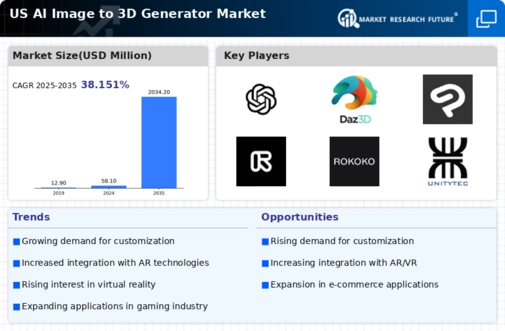Growing Popularity of E-commerce
The growing popularity of e-commerce significantly impacts the ai image-to-3d-generator market. As online retailers strive to provide enhanced shopping experiences, the demand for high-quality 3D product representations increases. In 2025, it is estimated that e-commerce sales in the US will surpass $1 trillion, prompting retailers to adopt advanced technologies that improve product visualization. The ability to generate realistic 3D models from images allows e-commerce platforms to showcase products more effectively, leading to higher conversion rates. Consequently, the ai image-to-3d-generator market is poised to benefit from this trend, as businesses seek to leverage 3D technology to attract and retain customers in a competitive online landscape.
Technological Advancements in AI
Technological advancements in artificial intelligence significantly influence the ai image-to-3d-generator market. Innovations in machine learning algorithms and computer vision enhance the capabilities of these generators, allowing for more accurate and efficient transformations of 2D images into 3D models. In 2025, the AI technology sector is expected to grow at a CAGR of 25%, which directly impacts the development of tools within the ai image-to-3d-generator market. As these technologies evolve, they enable users to create complex 3D structures with minimal input, thereby reducing production time and costs. This evolution not only attracts new users but also encourages existing users to adopt more sophisticated solutions, further driving market growth.
Emergence of Customization Trends
The emergence of customization trends within various industries drives the growth of the ai image-to-3d-generator market. Consumers increasingly seek personalized products and experiences, prompting businesses to adopt technologies that facilitate customization. In 2025, the market for personalized products is expected to grow by 20%, highlighting the need for tools that enable rapid prototyping and design modifications. Ai image-to-3d-generators provide the flexibility required to create tailored 3D models based on individual customer preferences. This capability not only enhances customer satisfaction but also allows companies to differentiate themselves in crowded markets. As a result, the ai image-to-3d-generator market is likely to see increased adoption as businesses strive to meet the demands of a more personalized consumer landscape.
Rising Demand for 3D Content Creation
The ai image-to-3d-generator market experiences a notable surge in demand for 3D content across various sectors, including gaming, architecture, and e-commerce. As businesses increasingly recognize the value of immersive visual experiences, the need for efficient 3D modeling tools becomes paramount. In 2025, the market for 3D content creation is projected to reach approximately $10 billion in the US, indicating a robust growth trajectory. This demand is driven by the necessity for high-quality visual representations that enhance user engagement and improve marketing strategies. Consequently, the ai image-to-3d-generator market is positioned to capitalize on this trend, providing innovative solutions that streamline the content creation process and cater to diverse industry needs.
Increased Investment in Creative Industries
Investment in creative industries plays a crucial role in the expansion of the ai image-to-3d-generator market. As venture capital and funding for startups in sectors such as gaming, film, and advertising rise, there is a corresponding increase in the demand for advanced 3D modeling tools. In 2025, creative industries in the US are projected to receive over $50 billion in investments, fostering innovation and the development of new technologies. This influx of capital allows companies to explore cutting-edge solutions, including ai image-to-3d-generators, which can significantly enhance their creative output. As a result, the market is likely to see a proliferation of new entrants and innovative products that cater to the evolving needs of these industries.

















Leave a Comment